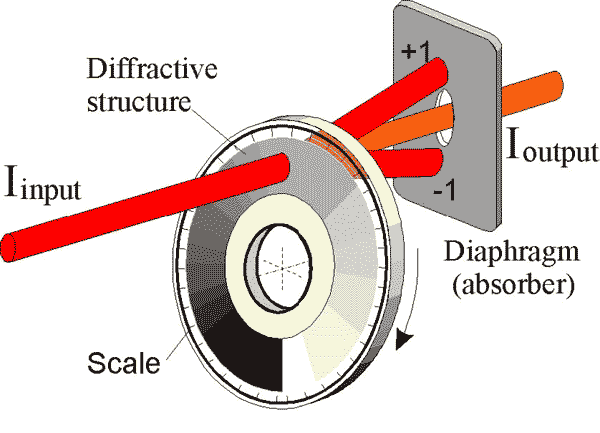
Variable Attenuators for High Power Lasers
Diffractive attenuators control the power
of laser radiation using diffraction gratings. Since phase diffraction gratings
do not absorb light they can be used for high-power laser radiation (cw,
pulsed). Variation of grating parameters along the substrate results in variable
transmission at a given wavelength.
Diffractive attenuators can be designed for wavelength from deep UV till IR for
laser powers up to 250W/cm2 in CW and 1000mJ/cm2 in 10ns
pulses.
Principle of operation
Light beam passing through a diffractive grating is partially deflected into several diffractive orders, which get subsequently blocked by diaphragm. Thus the zero order beam (does not change the direction of propagation) is attenuated. The intensity of output radiation Ioutput depends on the grating design and wavelength of input beam. By changing the grating parameters one can control the power of output radiation1. The transmission coefficient of such an attenuator is h = Ioutput/Iinput..
Design of diffractive attenuator on the base of circular diffractive grating.

Key features
Applications
Attenuator design

Specifications
|
Substrate material - surface flatness - wedge - outside-, inside diameter - thickness - clear aperture Design wavelength Transmission range Transmission function Deviation from linearity of transmission Polarization Coating S1, S2 Damage threshold Cleaning |
UV grade fused silica l/4 @ 532nm over clear aperture <20 arcsec 60 mm, 8mm 4 mm 10 mm 532nm, 1064nm (others wavelengths on request) T = 0.01 (0.025) – 0.95 ± 5% over 340o linear (approximated by stair case with 20 steps) <5% Transmission not dependent on polarization Broadband antireflection coating, R532/1064<0.3% 250 W/cm2 -CW, 1000 mJ/cm2 with 10ns pulses Non-abrasive method, acetone or isopropyl alcohol |
Diffractive attenuator with mount

|
||||||||||||||||||
|
|
||||||||||||||||||
|
||||||||||||||||||
Prices subject to change. Please e-mail us to confirm